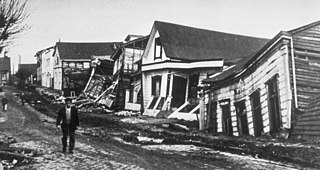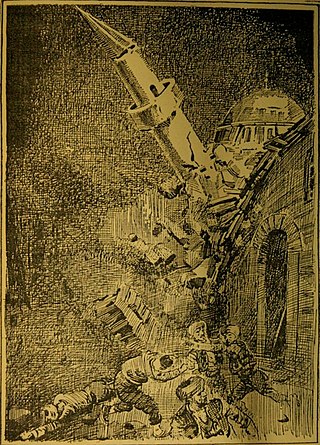Related Research Articles
The 1450s decade ran from January 1, 1450, to December 31, 1459.
Year 1459 (MCDLIX) was a common year starting on Monday of the Julian calendar.

Year 1509 (MDIX) was a common year starting on Monday of the Julian calendar.
Year 1474 (MCDLXXIV) was a common year starting on Saturday of the Julian calendar.

Year 1427 (MCDXXVII) was a common year starting on Wednesday of the Julian calendar.

The 1960 Valdivia earthquake and tsunami or the Great Chilean earthquake on 22 May 1960 was the most powerful earthquake ever recorded. Various studies have placed it at 9.4–9.6 on the moment magnitude scale. It occurred in the afternoon, and lasted for approximately 10 minutes. The resulting tsunamis affected southern Chile, Hawaii, Japan, the Philippines, eastern New Zealand, southeast Australia, and the Aleutian Islands.
The year 1573 in science and technology included many events, some of which are listed here.

Juan de la Cosa was a Castilian navigator and cartographer, known for designing the earliest European world map which incorporated the territories of the Americas discovered in the 15th century. De la Cosa was the owner and master of the Santa María, and thus played an important role in the first and second voyage of Christopher Columbus to the West Indies.

The Casa de Contratación or Casa de la Contratación de las Indias was established by the Crown of Castile, in 1503 in the port of Seville as a crown agency for the Spanish Empire. It functioned until 1790, when it was abolished in a government reorganization.

The Puerto Rico Trench is located on the boundary between the Caribbean Sea and the Atlantic Ocean. The oceanic trench, the deepest in the Atlantic, is associated with a complex transition between the Lesser Antilles subduction zone to the south and the major transform fault zone or plate boundary, which extends west between Cuba and Hispaniola through the Cayman Trough to the coast of Central America.

Matthias Ringmann (1482–1511), also known as Philesius Vogesigena was an Alsatian German humanist scholar and cosmographer. Along with cartographer Martin Waldseemüller, he is credited with the first documented usage of the word America, on the 1507 map Universalis Cosmographia in honour of the Italian explorer Amerigo Vespucci.

Marie Tharp was an American geologist and oceanographic cartographer. In the 1950s, she collaborated with geologist Bruce Heezen to produce the first scientific map of the Atlantic Ocean floor. Her cartography revealed a more detailed topography and multi-dimensional geographical landscape of the ocean bottom.

Diogo Ribeiro was a Portuguese cartographer and explorer who worked most of his life in Spain where he was known as Diego Ribero. He worked on the official maps of the Padrón Real from 1518 to 1532. He also made navigation instruments, including astrolabes and quadrants.

Santoña is a town in the eastern coast of the autonomous community of Cantabria, on the north coast of Spain. It is situated by the bay of the same name. It is 45 kilometres (28 mi) from the capital Santander. Santoña is divided into two zones, an urban plain, and a mountainous area, with Mount Buciero at its eastern limit, and Brusco and the beach of Berria to the north. The beach of San Martin comprises its south limit and the fishing harbor and marsh area its western limit.

The 1509 Constantinople earthquake or historically Kıyamet-i Sugra occurred in the Sea of Marmara on 10 September 1509 at about 10 p.m. The earthquake had an estimated magnitude of 7.2 ± 0.3 on the surface wave magnitude scale. A tsunami and forty-five days of aftershocks followed the earthquake. The death toll of this earthquake is poorly known, with estimates in the range of 1,000 to 13,000.
The 365 Crete earthquake occurred at about sunrise on 21 July 365 in the Eastern Mediterranean, with an assumed epicentre near Crete. Geologists today estimate the undersea earthquake to have been a moment magnitude 8.5 or higher. It caused widespread destruction in the central and southern Diocese of Macedonia, Africa Proconsularis, Egypt, Cyprus, Sicily, and Hispania (Spain). On Crete, nearly all towns were destroyed.
Americus is an unincorporated community in Montgomery County, in the U.S. state of Missouri.

The 1766 Istanbul earthquake was a strong earthquake with epicenter in the eastern part of the Sea of Marmara, in the Çınarcık Basin which occurred in the early hours of Thursday morning, 22 May 1766. The earthquake had an estimated magnitude of 7.1 on the surface wave magnitude scale, and caused effects in a vast area extending from Izmit to Rodosto. In this area, the earthquake was followed by a tsunami which caused significant damage. The earthquake of 1766 was the last major earthquake to rock Constantinople because of a rupture of the North Anatolian Fault in the Marmara region.
References
- ↑ Ambraseys, N. N. (December 2001). "The Earthquake of 1509 in the Sea of Marmara, Turkey, Revisited" (PDF). Bulletin of the Seismological Society of America. 91 (6): 1397. Bibcode:2001BuSSA..91.1397A. doi:10.1785/0120000305.[ permanent dead link ]